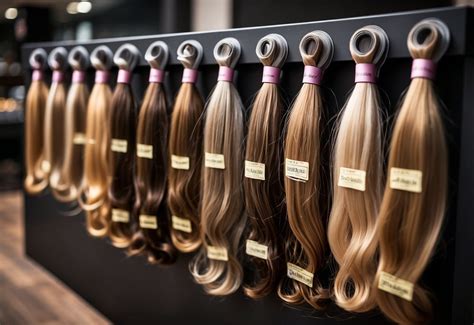Introduction

Hair extensions have become increasingly popular in recent years as a way to add length, volume, and style to one’s natural hair. However, the cost of hair extensions can vary significantly depending on several factors, including the type of hair, the length and thickness, the desired style, and the method of application. This comprehensive guide will explore the various costs associated with hair extensions to help you make an informed decision before investing in this beauty enhancement.
Table 1: Average Cost of Hair Extensions by Type
| Hair Type | Cost |
|---|---|
| Synthetic | $100-$500 |
| Human Remy | $200-$1,000 |
| Virgin Human | $300-$1,500 |
Factors Influencing Cost
Hair Type
As mentioned in Table 1, the type of hair used significantly impacts the cost of hair extensions. Synthetic hair is the most affordable option, but it tends to be less durable and more prone to tangling and matting than human hair. Human Remy hair, which refers to hair that has been collected and processed without altering the cuticle layer, is more expensive but offers a more natural look and feel. Virgin human hair, which has never been chemically treated or colored, is the most expensive but is also the most luxurious and longest-lasting option.
Length and Thickness
The length and thickness of the hair extensions also contribute to the overall cost. Longer hair extensions typically cost more than shorter extensions, and thicker extensions cost more than thinner extensions. This is because longer and thicker hair requires more materials and labor to produce.
Desired Style
The desired style of the hair extensions can also impact the cost. Simple styles, such as straight or wavy extensions, are less expensive than more complex styles, such as curls or braids. This is because more complex styles require more time and skill to create.
Application Method
The method of application is another factor that can influence the cost of hair extensions. There are various application methods available, including clip-ins, tape-ins, fusion, and sew-in. Clip-in extensions are the most affordable option, while fusion and sew-in extensions are typically the most expensive. This is because fusion and sew-in extensions require more technical skill and time to apply.
Table 2: Average Cost of Hair Extensions by Application Method
| Application Method | Cost |
|---|---|
| Clip-ins | $100-$300 |
| Tape-ins | $200-$500 |
| Fusion | $500-$1,000 |
| Sew-in | $500-$1,200 |
Additional Costs
In addition to the direct cost of the hair extensions, there are several other costs to consider when budgeting for this beauty enhancement. These additional costs may include:
- Installation: The cost of installation will vary depending on the application method and the salon you choose.
- Maintenance: Hair extensions require regular maintenance to keep them looking their best. This may include washing, conditioning, and styling the extensions.
- Removal: When it is time to remove the hair extensions, there may be a removal fee.
Benefits of Hair Extensions
Despite the potential costs, hair extensions offer numerous benefits that can make the investment worthwhile. These benefits include:
- Length and Volume: Hair extensions can instantly add length and volume to thin or short hair, creating a fuller and more voluminous look.
- Style Versatility: Hair extensions allow you to experiment with different styles without making a permanent commitment. You can add curls, waves, or even braids to your natural hair without damaging it.
- Corrective Measures: Hair extensions can be used to correct hair loss or damage. They can cover up bald spots or areas of thinning hair, giving you a more confident look.
- Time Savings: Hair extensions can save you time on styling your hair. Pre-styled extensions can be applied in minutes, giving you a polished look with minimal effort.
Conclusion
The cost of hair extensions can vary significantly depending on several factors. However, the benefits of hair extensions, including length, volume, style versatility, corrective measures, and time savings, make them a valuable investment for those looking to enhance their appearance. By understanding the various costs associated with hair extensions, you can make an informed decision about whether this beauty enhancement is right for you.
Table 3: Cost Range of Hair Extensions by Length
| Length | Cost Range |
|---|---|
| Short (12-16 inches) | $100-$500 |
| Medium (18-22 inches) | $200-$800 |
| Long (24-28 inches) | $300-$1,000 |
Table 4: Cost Range of Hair Extensions by Thickness
| Thickness | Cost Range |
|---|---|
| Thin | $100-$400 |
| Medium | $200-$600 |
| Thick | $300-$800 |
Strategies for Reducing Cost
If you are looking to reduce the cost of hair extensions, consider the following strategies:
- Choose synthetic hair: Synthetic hair is the most affordable option and can still provide a natural look.
- Opt for shorter and thinner extensions: Shorter and thinner extensions require less materials and labor to produce, which can save you money.
- Consider clip-in extensions: Clip-in extensions are the most affordable application method and can be easily applied and removed at home.
- Look for discounts and promotions: Many salons and online retailers offer discounts and promotions on hair extensions, especially during the off-season.
- Extend the lifespan of your extensions: With proper care and maintenance, you can extend the lifespan of your hair extensions, saving money in the long run.
